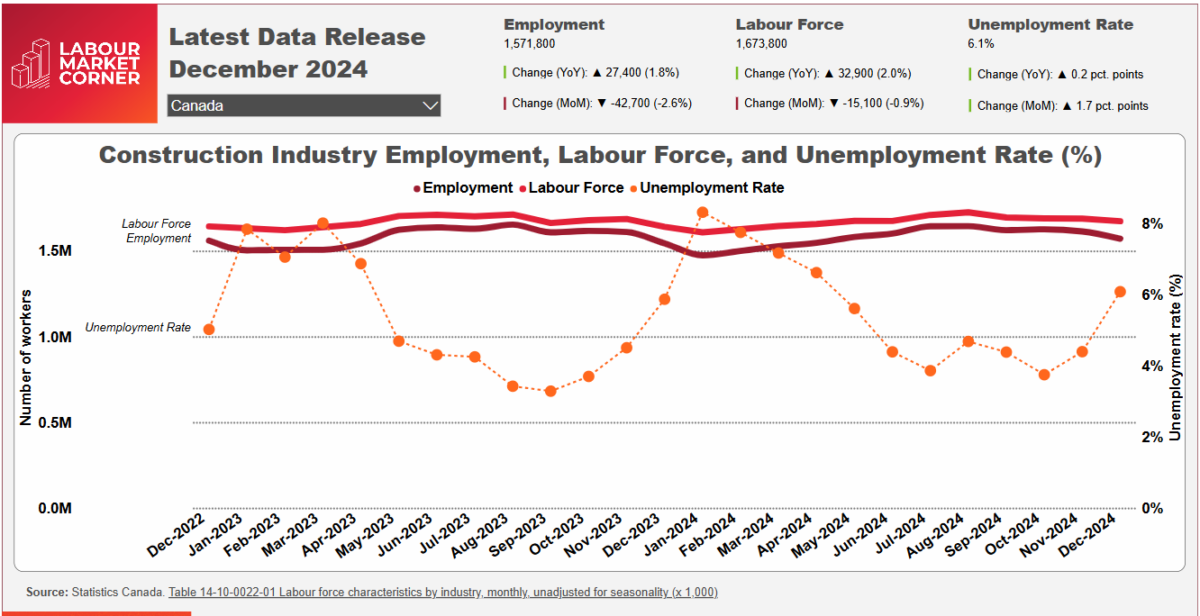Construction employment and its labour force both reported gains for the 12-month period ending in December 2024, with double-digit gains in both indicators reported among two key demographics: all females and all young workers.
The most recent Labour Force Survey data from Statistics Canada, for December 2024, shows increases in both industry employment (1.8%) and the labour force (2.0%) for all workers over the last 12 months. Because the labour force grew faster than employment over the year, the industry’s unemployment rate ticked up from 5.9% to 6.1%.

A closer look at the data reveals two noteworthy trends that have carried through much of 2024: growth among the industry’s youngest workers and among female workers aged 15 years and over.
Among men and women aged 15 to 24 years, employment and labour force metrics rose by 19.2% and 16.8%, respectively. Meanwhile, employment and labour force metrics rose by 11.4% and 13.7% among women aged 15 years and over. Employment was also higher among core-aged females (i.e., those aged 25 to 54 years) and among older female workers (i.e., those aged 55 years and over), but this growth was partially offset by a contraction in employment among female workers aged 24 years and younger.
Across the country, six provinces reported growth in construction employment in 2024. These were led by strong absolute gains in Alberta (+17,800 workers; +7.5%) and British Columbia (+16,000 workers; +7.1%). Other provinces reported gains of between 6,800 workers (Nova Scotia) and 1,800 workers (Prince Edward Island). Although employment gains in the latter provinces were relatively smaller in absolute values, they represent significant growth in the provincial context. Employment grew by 18.1% in Nova Scotia, 23.1% in Prince Edward Island, and 14.3% in Saskatchewan.
Growth in both Alberta and British Columbia appears to have been spurred by strong demand for residential construction, combined with a number of ongoing major non-residential projects. For November 2024, housing starts in Alberta were up 48% compared to the same month in 2023, while starts rose by 33% in British Columbia.
Among the four provinces that experienced year-over-year employment losses, Ontario reported the greatest contraction at -17,900 workers, or -3.1%. Manitoba, New Brunswick, and Newfoundland and Labrador also reported contractions.
Although a significant number of major construction projects are underway across the province, Ontario has experienced lower volumes of construction activity to date in 2024. Lower levels of new-home construction have offset strong activity in the province’s non-residential sector.
As of November 2024, the number of housing starts year-to-date in the province was down by 18%, while the number of building permits issued in the province was down by 7%. Workers involved primarily in the construction of high-rise residential buildings and in the Greater Toronto Area and surrounding regions likely felt weaker demands throughout most of 2024 as contractions were concentrated in these unit types and regions.
These trends are likely being driven by the ongoing effects of the high-interest rate environment. Inflation and elevated borrowing costs have slowed consumer spending on residential construction in particular and have slowed overall levels of consumer spending that have, in turn, reduced businesses’ appetites to expand their operations. Recent cuts to the Bank of Canda’s prime lending rate are expected to reverse these trends in the months ahead.
Finally, construction unemployment rates in most provinces varied between 5.4% and 6.0% for December 2024, with only three provinces (Saskatchewan, New Brunswick, and Newfoundland and Labrador) reporting rates above the national average of 6.1%.

Construction Key Indicators
